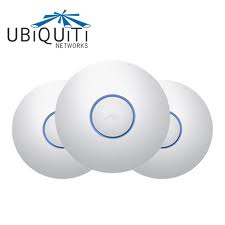 So I have been on the hunt for a wifi system that would auto-transfer devices from one Access Point (AP) to another. Due to an issue that Apple has not fixed (and seemingly will not fix) is auto-transferring clients from one to another.
So I have been on the hunt for a wifi system that would auto-transfer devices from one Access Point (AP) to another. Due to an issue that Apple has not fixed (and seemingly will not fix) is auto-transferring clients from one to another.
Is Unifi AP long-distance the answer? I will find out and post the results here once I have tried it out.
UPDATE: YES – BUY THESE. THEY ARE AWESOME (and why not a 3 pack!). They have guest Wifi (with ability to join a VLAN) and normal modes. They are easy to configure – real easy. See my next article to know how to use them with a pfSense router with a VLAN for a guest network.
[UPDATE Fall 2015: Important anti-frustration tips at bottom of my other article … I have installed 3 customers with these units and STILL love it … just follow those updates’ advise.]
History this far. I have several clients who are in 1970’s re-bar filled buildings where wifi does not penetrate. Wifi extensions like WDP share the bandwidth between clients and each other as a backbone – hence the bandwidth is just not full. One client who is mostly mac computers work fine around the building no matter what philosophy one uses but iOS (iPhone, iPads etc.) do not transfer. Those devices hang on desperately hang on to the wifi signal even if a stronger one with the same or different (I have tried both) SSID is used. If you turn the wifi on and off – it picks up the new strong signal no issue. I have tools that monitor signals, MAC addresses and signal strength.
Unless one goes to a properly managed wifi system ($1500+) using different SSID’s around the building is the most intuitive way for small businesses is the way to go. People just get it “hey, this one sucks – lets try this other one that has -more bars-“.
However, this is no way to run a system. WDS is the other obvious answer but being a purist – it bothers me especially if many are used – then the speed gets slow within the building and laptops (which are used for normal file stuff) also suffer.
Two of my clients are churches – so a B-Class (255 * 255 clients) network is important and bandwidth is at a premium so WDS is not acceptable. Now we bought an over-priced ($280) Cisco router and their B-Class is STILL limited to 255 clients – this is a mis-representation since B-Class means 255*255 and they do have a class B pulldown. My plan is to somehow mix a pfSense box with some of these AP’s and see how the roaming/handoff is as well as how many devices we can put on this guest network.
I will post my results here or put a link here to a new article. Wish me luck. UPDATE: It worked – it is awesome. Click here to view my suggestions on configuring things and which articles helped me out and could help you out too.
Ordering list:
http://soekris.com/products/net5501-70-board-case.html
http://soekris.com/products/psu/psu-12v-3-0a-world.html (Qty: 2 just in case)
Reading between the lines – 192.168.0.0/16 is an invalid network. I made the same mistake 15 years ago, and the only thing that complained at the time was a Linksys WRT54GL.
Turns out that in the days of classful networks, 192.168 is 255 separate /24 networks and should not be treated like a single /16. Some kit enforces this restriction still.
So your best bet is to use 10.somethingunique..x.y/16 or 172.16-31.0.0/16
Mental! Thanks for this – what you said is an easy work around. I still use Unify stuff – but it can be a pig to set up and … it does last a long without touching it so I book 2x as long as it should take. It takes 4x though 😉
for KRACK – having troubles upgrading. For the DEVICES (eg AP-LR, AP-PRO etc) TAKE THE s off the https:///to/their/bin/file when you drop the upgrade path to the Unit’s upgrade path. Took me 3 hours. I have 13 of these to upgrade for 3 clients. ARRRGGGG. I still they are a pig, but their “easy update” is getting better and better.